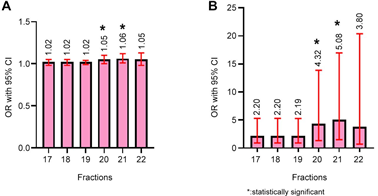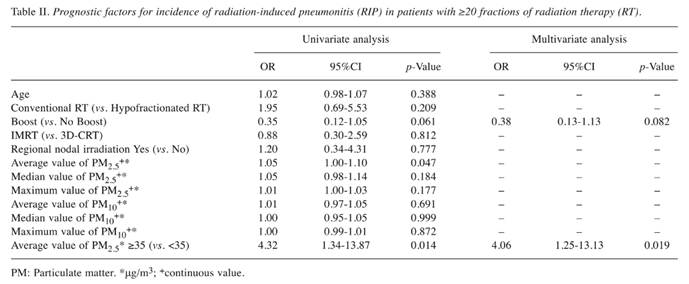글로벌 연구동향
방사선종양학
- 2024년 05월호
[In Vivo .] The Impact of PM2.5 on Radiation-induced Pneumonitis in Patients With Breast Cancer서울의대 / 김동연, 장범섭*
- 출처
- In Vivo .
- 등재일
- 2024 Mar-Apr
- 저널이슈번호
- 38(2):928-934. doi: 10.21873/invivo.13521.
- 내용
Abstract
Background/aim: Exposure to particulate matter (PM) air pollution is known to adversely affect respiratory disease, but no study has examined its effect on radiation-induced pneumonitis (RIP) in patients with breast cancer.Patients and methods: We conducted a retrospective review of 2,736 patients with breast cancer who received postoperative radiation therapy (RT) between 2017 and 2020 in a single institution. The distance between the PM measurement station and our institution was only 3.43 km. PM data, including PM2.5 and PM10, were retrieved from the open dataset in the official government database.
Results: Overall incidence rate of RIP was 1.74%. After adjusting for age, RT technique, regional irradiation, fractionation and boost, the average value of PM2.5 was significantly associated with a higher risk of RIP (p=0.047) when patients received ≥20 fractions of RT. Specifically, PM2.5 ≥35 (μg/m3) showed a significantly higher risk of RIP (p=0.019) in patients with ≥20 fractions of RT.
Conclusion: This is the first study to reveal the association between PM2.5 and RIP in patients with breast cancer who received 20 fractions or more of postoperative RT. We demonstrated that high PM2.5 levels around the RT institution were associated with RIP, suggesting that reducing PM air pollution may be a modifiable risk factor.
Figure: Analyses of the relationship between particulate matter (PM) data [overall average PM2.5 values (A) and PM2.5 values ≥35 (B)] and radiation-induced pneumonitis, stratifying the number of radiation therapy (RT) fractions. Significantly increased odds ratio (OR) over 20 fractions of RT for both overall average PM2.5 values and PM2.5 values ≥35 was found.

Table. Prognostic factors for incidence of RIP in patients with ≥ 20 fractions of RT

Affiliations
Dong-Yun Kim 1 2, In Ah Kim 1 3, Bum-Sup Jang 4 5
1Department of Radiation Oncology, Seoul National University College of Medicine, Seoul, Republic of Korea.
2Department of Radiation Oncology, Chung-Ang University Hospital, Seoul, Republic of Korea.
3Department of Radiation Oncology, Seoul National University Bundang Hospital, Seongnam, Republic of Korea.
4Department of Radiation Oncology, Seoul National University College of Medicine, Seoul, Republic of Korea; bigwiz83@snu.ac.kr.
5Department of Radiation Oncology, Seoul National University Hospital, Seoul, Republic of Korea.
- 키워드
- Particulate matter; breast cancer; radiation-induced pneumonitis; radiotherapy.
- 연구소개
- 미세먼지 (PM)는 공중 보건을 위협하는 요인으로, 지속적으로 노출 시 기도 염증을 유발하여 폐 면역 체계를 손상시키는 만성 염증을 유발할 수 있는 것으로 알려져 있습니다. 유방암 환자에서 수술 후 방사선치료를 받는 경우 염증성 폐 질환의 한 종류인 방사선유발폐렴 (RIP)이 발생할 수 있는데, 특정 수준 이상의 나쁜 미세먼지가 RIP 발생의 위험을 높일 수 있다는 가정에서 본 연구를 시작하였습니다. 본 연구에서는 단일기관에서 수술 후 방사선치료를 받은 유방암 환자 2,736명을 대상으로 임상데이터를 수집하였고, 병원 인근 측정소에서 수집한 정부의 공식 미세먼지 데이터를 검색하여 방사선치료 세션 동안 개별적으로 노출된 미세먼지 농도를 분석했습니다. 분석 결과, 병원 주변의 높은 PM2.5 수치가 20회 이상 방사선치료를 받는 환자의 RIP 발생 위험을 증가시킨다는 것을 발견했습니다. 이는 대기오염 노출이 유방암 수술 후 방사선치료의 부작용을 악화시킬 수 있다는 것을 보고한 최초의 연구라는 점에서 의의가 있습니다. 나아가 미세먼지가 심각한 환경문제로 인식되는 현 시대에, 치료관련 부작용을 줄이기 위해 방사선치료 횟수, fractionation등을 고려하는 임상의의 치료 방법 결정에 도움이 될 수 있을 것이라 생각합니다.
- 덧글달기








편집위원
대기질 측정정보에서 획득한 PM2.5 및 PM10 데이터를 이용하여 미세먼지와 유방암 방사선치료 후 방사선폐렴의 빈도와의 관련성을 최초로 보고한 논문임.
덧글달기닫기2024-05-03 11:01:47
등록